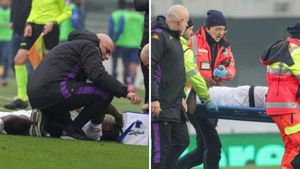Thousands of demonstrators took to the streets across Italy on February 22, 2025, to protest against the controversial DDL Sicurezza bill, which many have labeled as the "DDL paura" or fear bill. These protests were not just ordinary demonstrations; they coincided with the annual commemoration of Valerio Verbano, who was murdered 45 years ago by far-right extremists. The significance of this date amplified the sentiments of historical oppression and the perceived threats posed by the new legislation.
Protests unfolded simultaneously in various cities, including Rome, Milan, Bologna, and Naples, with demonstrators expressing solidarity across generational lines. According to reports, participants at the Bologna protest numbered over 5,000, uniting under banners held by social centers, unions, and activist groups. The mood was electric, with chants echoing through the streets—"No to police zones!" being one of the most prevalent slogans shouted from the crowds.
Among the attendees was Nicola Ricci, the regional secretary of CGIL Campania, who voiced strong concerns over the bill’s potential consequences: "With these norms, one student or worker manifesting for the right to study or defend their job risks up to two years of prison." Such statements reflect widespread fears about the erosion of civil liberties and this bill's impact on democratic engagement.
The DDL Sicurezza is seen as part of the Italian government's response to rising social tensions, characterized by broader calls for justice and equity. Critics claim it responds to societal issues with increased repression rather than addressing the root causes of inequality and unrest. An activist from the Bologna protest stated, "The DDL Sicurezza is the ideological manifesto of the Meloni government, taking us toward illiberal democracy," emphasizing the bill's draconian measures against dissent.
Demonstrations were marked by a blend of youthful energy and historical remembrance, especially poignant during the Rome march, which also honored Valerio Verbano's legacy. There, many rallied at his former residence on Via Monte Bianco before marching against the government’s tightening grip over civic freedoms. Participants included noted figures such as the comic artist Zerocalcare, who amplified the call for justice, linking current struggles to historical contexts.
Milano witnessed similarly fervent protests as participants, estimated at around 2,000, gathered at Piazza 24 Maggio. The march's concluding point was marked by loud calls for accountability concerning recent incidents involving police violence linked to the tragic death of Ramy, another young man lost under contentious circumstances. The event seamlessly flowed between demands for justice and opposition to the DDL, reinforcing the connection between past injustices and present fights for rights.
Meanwhile, Napoli's streets were vibrant with banners and voices rallying against the DDL. The local CGIL chapter echoed sentiments shared across the nation, stating, "This legislation threatens the foundation of our democracy, ensuring dissent remains silenced. We must guarantee the right to protest and mobilize for social justice."
Here, the phrase "No to the Caivano model!" particularly stood out, reflecting local issues with repression and socio-economic disparities. This line poignantly captures the discontent simmering throughout various Italian urban centers.
The protests did not lack drama; some rallies experienced moments of heightened tension, especially where law enforcement was involved. Despite various incidents, no significant confrontations were reported, highlighting the organization and commitment of demonstrators to peacefully articulate their grievances.
Further, smaller gatherings took place across Italy, including cities like Cagliari and Treviso, with participants uniting under similar messages opposing the DDL Sicurezza. Attendees at these events brought cultural references, showcasing creative expressions through art and music, prominently showcasing the hope for societal change.
Looking forward, as the Senate prepares to discuss the bill on March 4, the landscapes of Italian cities are ripe with anticipation and defiance. The breadth of these protests indicates not only opposition to the DDL Sicurezza but also signals a broader movement for protecting civil liberties. Observers are aware: this protest is not the end—it is the beginning of renewed activism, aiming for societal reformation and the reaffirmation of basic human rights.
The protests have sent a clear message: security should not be confused with oppression. "Security should not be built through repression but through dignified work and adequate public services," state various organization leaders, calling for systemic change rather than punitive measures. The DDL Sicurezza might appear as legislation, but to many, it is much more than words on paper; it is considered to be signature of fear where safety and freedoms collide.



